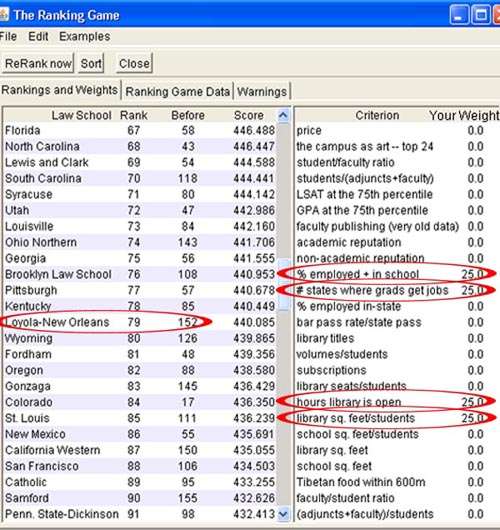Another point is that the current rankings are more permanently calcified the higher you go. One anecdote Gladwell relates proves this: several years ago, a judge asked some colleagues to rank ten law schools he listed. The rankings were no surprise, except that Pennsylvania State was ranked solidly in the middle. The punch line is Penn State did not have a law school at the time, though it does now. If Penn State is a good university, it must have a good law schools, whatever the facts, or even if it, in fact, did not have a law school at all.
Gladwell mentions the Law School Rankings Game, a web page run by Indiana U, Bloomington law professor Jeffrey Stake. This is an interactive page with the raw ABA data that users can weight in any combination to produce their own rankings through an endless possible combination of criteria. This is what Gladwell uses to give law school tuition a much higher weight than the U.S. News rankings gives it, producing a significantly different list of top ten schools.
I played with the possible factors and weights at the Rankings Game to see if I could find a combination that would get Loyola up in the top quarter of law schools, but the closest I could get was 79th, by giving an even four-way weight to these factors:
states where grads get jobsHere’s the results:
% employed in state
hours library is open
library square feet/student

I knew our library square feet (per student) and hours open are pretty good, and though the first two factors would seem to balance each other out, I know around half our students are from, or stay in, Louisiana, and that the rest of our students are from all over, with only tiny clusters in any one other state.
Incidentally, our “152nd” ranking is unofficial: the ABA does not rank schools in the lower tiers, but this is Prof. Stake’s reverse-engineering of the ABA rankings (according to Gladwell), using a four-way weight of:
academic reputationThe last of the four, faculty publication, I know for a fact the ABA doesn’t collect in its annual questionnaire (which is one of the sources of the U.S. News rankings data), so I don’t know where the U.S. News gets those numbers from. Prof. Stake’s Rankings Game indicates that the publications numbers are “very old data” so either U.S News uses one of the ratings of faculty publications that get published every few years, or asks its survey takers for a subjective evaluation of faculty publication, which means this is just another flavor of “academic reputation.”
LSAT scores at the 75th percentile
student-faculty ratio
faculty law-review publication
So give it a try and play the Rankings Game yourself and see what results you can create!
No comments:
Post a Comment